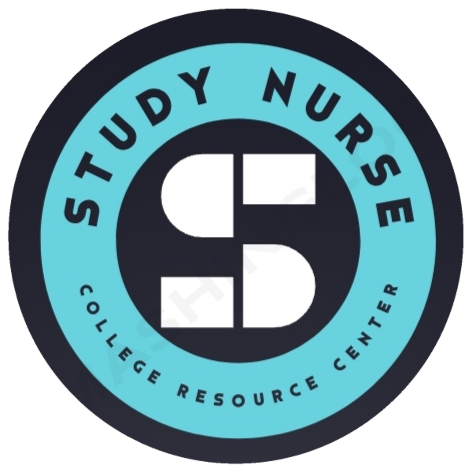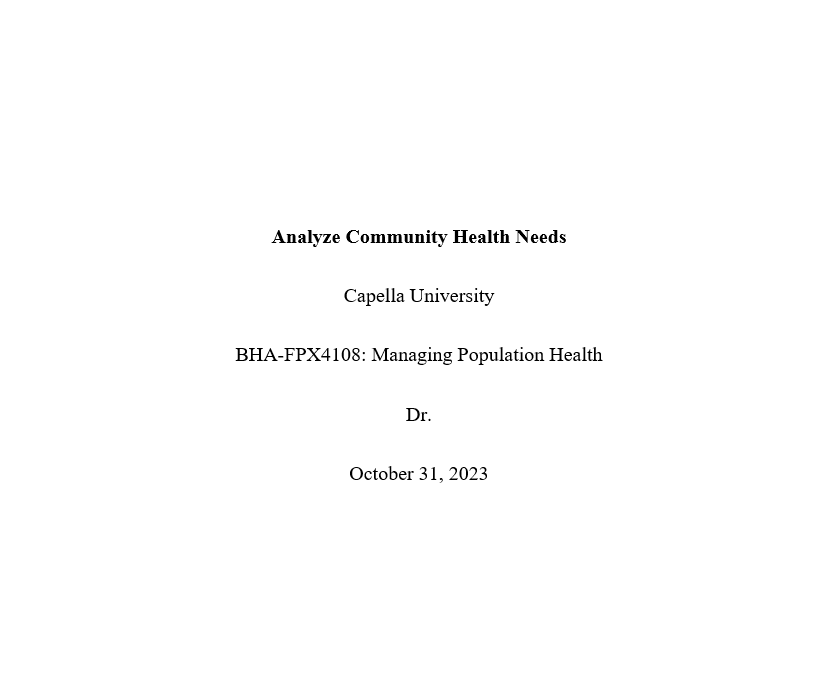Capella University
BHA-FPX4108: Managing Population Health
Dr.
October 31, 2023
Analyze Community Health Needs
Analyzing community health needs is a priority for healthcare providers, policymakers, healthcare professionals, and other stakeholders committed to improving individual and population health. The process provides insights into the various determinants of health and interventions appropriate to improve quality of life. Bronx, New York is among communities that could benefit from a comprehensive analysis of residents’ health challenges and improvements.
Salient Characteristics of the Community
The Bronx has an estimated population of 1,418,207 people. The median age is 34.4. The composition of the population includes 3.7% Asians, 29% African Americans, 56.4% Hispanics, and 8.8% (Whites Furman Center for Real Estate and Urban Policy, 2022). The average household income in the Bronx is $43,540. The poverty rate was 6.4% in 2019, which is higher than the national average of 16% (Furman Center for Real Estate and Urban Policy, 2022). Poverty is a serious concern in the region and among the primary determinants of health. The high rates expose individuals, including children, youths, and adults to adverse health outcomes. Geographically, the region is in the southeastern part of New York and is primarily residential.
Health Improvement Needs
The Bronx faces multiple health issues with the main ones being diabetes, obesity, and substance abuse. The three reveal the need for proactive prevention, health promotion and education, and treatment to improve residents’ quality of life. The issues affect individuals’ mental and physical health by interfering with their ability to live healthier and more productive lives. The conditions also align with healthy behaviors, access to services, and health coverage that influence the quality of prevention and treatment measures (The Institute for Family Health, 2022). For instance, deaths from drugs, alcohol, and suicide are 39.87 for every 100,000 people. The deaths reveal the worrying levels of despair associated with substance abuse and limited opportunities for a better life.
The community experiences premature deaths, a declining economy, and worsening vitality associated with alcohol, tobacco, and other forms of abuse. Obesity is another health challenge with a prevalence rate of 30.3% (Well Being In the Nation Network, 2022). The condition increases the risk of diabetes, mental health issues, and heart disease. The community health needs highlight the need for an evidence-based approach to protecting vulnerable residents from worrying prevalence rates. The comprehensive plans include lifestyle changes triggered by increased health promotion and education to empower individuals to take charge of their health and well-being.
Engagement of Community Stakeholders
Sustainable improvements depend on contributions from multiple stakeholders. The interdisciplinary parties include community-based health organizations, healthcare facilities, the local government, employers, schools, and public health departments. The stakeholders have unique perspectives on health issues in the region and interventions necessary to improve the situation. For instance, community-based health organizations collaborate with CHWs, case managers, and social workers to enhance access to prevention, health promotion and education, and treatment for diabetes, obesity, and substance abuse. Similarly, healthcare facilities understand the prevalence and risks of escalating conditions based on patients’ records. In this case, hospitals can collaborate with schools and employers to deliver educational sessions, screen, and implement other strategies for children, youths, and adults.
The public health department is a key stakeholder that designs and implements evidence-based population-based interventions for reducing health burdens. The stakeholder initiates prevention and treatment measures guided by prevalence rates and the commitment to allocating and distributing resources and eliminating health disparities across the region. Low education levels are among the barriers that limit residents from embracing positive health-seeking behaviors and attitudes. Low income also undermines individuals’ ability to adopt recommended lifestyle modifications such as a healthy diet. Despite the challenges, worrying trends in diabetes, substance abuse, and obesity are likely to encourage residents to embrace habits that help improve their quality of life and maintain a productive community.
Treatment or Wellness Models for Community Health Needs
Intensive behavioral therapy is a viable option for treating obesity and substance abuse. The model entails empowering individuals to change their eating and adopt a healthy exercise routine. Targeting unhealthy behaviors such as poor eating and failure to exercise encourages individuals to track their diet, change their environment, increase their activity level, and set goals that match their values and preferences (Wadden et al., 2019). The advantages of intensive behavioral therapy include the ability to help individuals reduce weight, change their exercise and eating routines, and match a patient’s needs and expectations. However, the model has drawbacks such as the absence of alternative options for managing weight.
The preferred prevention model is self-management, which encourages individuals to embrace activities and behaviors necessary to control risks. Vulnerable groups monitor their health regularly by consuming balanced meals, engaging in physical activities, and seeking knowledge about risks associated with diabetes, substance abuse, and obesity (Rural Health Information Hub, 2022). The advantages of the self-management model entail the ability to encourage individuals to take charge of their health by modeling healthy behaviors. The model also enhances access to social support that helps build self-efficacy for diabetes self-management. However, patients are vulnerable to a shortage of financial and health resources, inadequate support, and inadequate knowledge that undermines the effectiveness of the prevention model.
Conclusion
Community health needs reveal the need for individual and collective commitment to reducing health burdens and disparities. Obesity, substance abuse, and diabetes are among the conditions that require evidence-based and sustainable measures to maintain a healthy and productive society. Multidisciplinary stakeholders should dedicate time and energy toward sharing unique perspectives on appropriate interventions for overcoming disease burdens.
References
Furman Center for Real Estate and Urban Policy. (2022). The Bronx. Furman Center for Real Estate and Urban Policy. https://furmancenter.org/neighborhoods/view/the-bronx
The Institute for Family Health. (2022). Our community. The Institute for Family Health. https://institute.org/bronx-health-reach/about/our-community/
Rural Health Information Hub. (2022). Self-management model. Rural Health Information Hub. https://www.ruralhealthinfo.org/toolkits/diabetes/2/self-management
Wadden, T., Walsh, O., Berkowitz, R., Chao, A., Alamuddin, N., Gruber, K., Leonard, S., Mugler, K., & Tronieri, J. S. (2019). Intensive behavioral therapy for obesity combined with Liraglutide 3.0 mg: A randomized controlled trial. Obesity, 27(1), 75-86. https://www.ncbi.nlm.nih.gov/pmc/articles/PMC6800068/pdf/nihms-1053477.pdf
Well Being in the Nation Network. (2022). Health in Bronx county, New York. Well Being in the Nation Network. https://www.winmeasures.org/statistics/winmeasures/new-york/bronx-county-health

